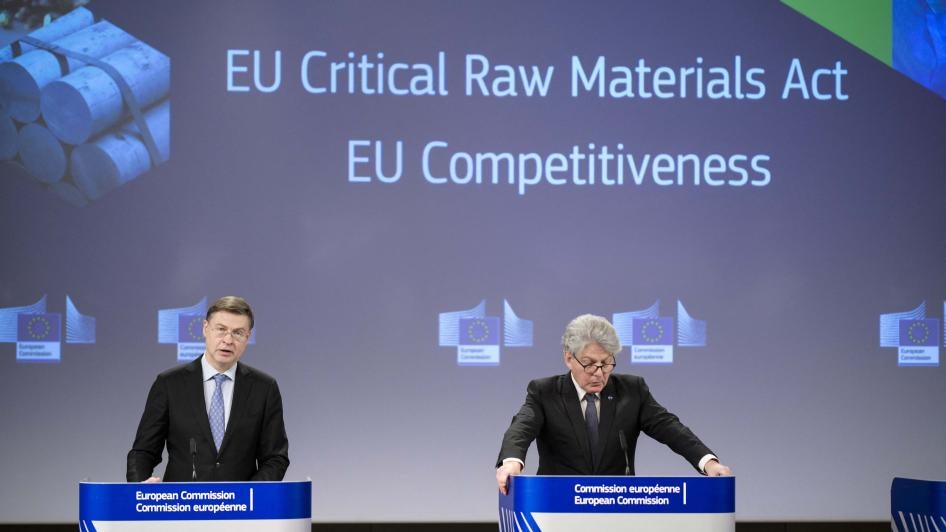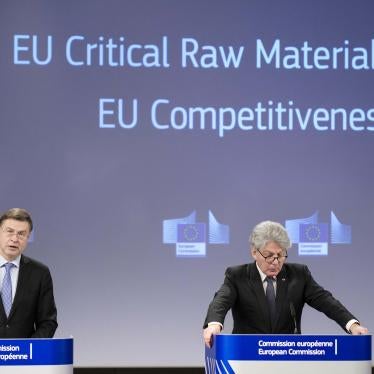The European Union’s effort to secure a sustainable and secure supply of minerals, including through the draft Critical Raw Materials Act, is increasingly relying on flawed voluntary audit and certification initiatives.
Research by Human Rights Watch and others has shown that third-party audits have inherent limitations and that voluntary initiatives frequently lack the detailed criteria and rigorous methodology needed to evaluate companies’ compliance with human rights or environmental standards.
The following questions and answers address concerns about using voluntary standards to monitor the human rights and environmental impacts of mineral supply chains, and describe what the EU should do to provide adequate monitoring.
What are mining and minerals audit and certification initiatives and what do they do?
Increased recognition of human rights and environmental risks in mining and mineral supply chains has led to a proliferation of voluntary initiatives that seek to assess and certify companies’ respect for human rights and the environment.
Voluntary initiatives typically rely on third-party auditors to assess companies or facilities against a standard developed by the initiative. These initiatives incorporate human rights and environmental standards to varying degrees. In many cases, initiatives also offer companies a “certification” that an audit has determined that the company complies with the relevant standard. Mining companies frequently cite certification results to regulators, customers, and investors as evidence of their responsible business conduct.
Audits and certifications in the minerals sector fall into two main categories. Facility-level initiatives evaluate respect for human rights, environmental, and labor standards at mines, refineries, and other facilities in mineral supply chains. An audit under a facility-level initiative, for example, might include an assessment of whether a mine is protecting the rights of its workers, whether it has adequate measures in place to prevent water pollution, and whether it is restoring the livelihoods of communities that have lost land to mining. The Standard for Responsible Mining, developed by the Initiative for Responsible Mining Assurance (IRMA), is primarily a facility-level standard, evaluating an individual mine’s compliance with the standard’s requirements.
The second type of voluntary initiative—a supply chain due diligence initiative—assesses whether companies source raw materials responsibly, based on standards like the Organisation for Economic Co-operation and Development (OECD)’s Due Diligence Guidance for Responsible Business Conduct and the OECD Due Diligence Guidance for Responsible Supply Chains of Minerals from Conflict-Affected and High-Risk Areas. An audit using a supply chain due diligence initiative assesses whether companies have policies and practices in place to identify the source of raw materials and to address the most important human rights and environmental risks at the locations they are sourcing from.
Supply chain due diligence initiatives are especially used to assess the sourcing practices of key “choke points” in a supply chain – the refineries or smelters that procure minerals from mines and play a key role in deciding what raw materials enter the global supply chain. The London Bullion Market Association (LBMA) Responsible Gold Guidance is an example of a supply chain due diligence scheme.
Some audit and certification programs, such as the Aluminum Stewardship Initiative’s (ASI) Performance Standard, incorporate both facility-level and supply chain due diligence standards, using audits to assess both a refinery or other facility’s respect for human rights and the environment and its oversight over the mines or other facilities it sources from.
Why is reliance on audits and certification by mining and minerals initiatives problematic?
Audits are an inherently unreliable indicator of whether a company truly respects human rights and the environment, and at best should be seen as one source of information about a company’s practices. Audits should only be one tool that companies and regulators use to assess a mine or other facility. They are not a replacement for a broader assessment of human rights and environmental performance.
Human Rights Watch and other organizations have documented the limitations of third-party audits, including problems maintaining independence when auditors are paid by the company being audited; conflicts of interest in audit firms that also solicit work from the firms they are auditing; and a lack of human rights expertise among auditors.
Audits are typically conducted in just a few days, so they only provide a snapshot of performance over the period the audit covers, creating a risk that serious human rights and environmental abuses are overlooked. In addition, many audit and certification initiatives were primarily developed by mining companies and other industry groups, without adequate representation from affected communities or civil society, limiting their ability to develop strong standards and rigorous audit processes.
Research by Human Rights Watch on audits and certification in gold and aluminum supply chains has found that the standards that initiatives used to assess companies involve inadequately detailed human rights and environmental requirements. They also place too great a focus on an evaluation of company policies and systems rather than on the impact of companies’ conduct on affected communities.
Initiatives also frequently do too little to require auditors to meaningfully consult affected communities and workers. The weight of the evidence considered by the auditor often comes overwhelmingly from the company to be audited, rather than also from other stakeholders, including those who may have suffered harm.
There is also often a lack of transparency regarding the findings of audits. Voluntary initiatives frequently do not publish detailed audit reports, information on the audit process, or details related to any non-compliance that was found. As a result, it is often difficult to determine why a voluntary initiative did or did not determine that a company met its standard.
Civil society organizations have also concluded that mining standards initiatives lack adequate mechanisms for ensuring that companies correct problems or weaknesses identified during audits, as well as effective grievance processes through which affected workers and communities can challenge the results of an audit and seek improvements in the audited company’s practices.
What is the EU Critical Raw Materials Act?
The European Union’s draft Critical Raw Materials Act, released on March 16, 2023, is intended to help the EU “secure a sustainable, resilient and diversified supply of critical raw materials to succeed in its green and digital transitions and provide for the needs of strategic European sectors such as defense and space.” The list of critical raw materials proposed for inclusion in the act includes cobalt, copper, lithium, graphite, nickel, and bauxite, the ore needed to make aluminum.
To strengthen EU access to raw materials, the draft act would empower the European Commission to designate new mines and other raw material projects along the supply chain, both inside and outside the EU, as “Strategic Projects.” Strategic Projects would be able to benefit from improved access to finance and streamlined procedures for permits, which could result in weakened environmental and human rights safeguards.
The law would require the European Commission to assess whether a potential Strategic Project “would be implemented sustainably,” including as regards monitoring, prevention, and minimization of environmental impacts and respect of human and labor rights.
The act instructs the commission to evaluate sustainability by assessing a project’s compliance with EU legislation such as the forthcoming Corporate Sustainability Due Diligence Directive. Companies covered by the directive, which is currently being negotiated by EU institutions, will be required to address adverse human rights and environmental impacts in their operations and value chains.
The act also requires the commission to assess a project’s compliance with certain international standards, including the United Nations Guiding Principles on Business and Human Rights and the OECD Due Diligence Guidance for Responsible Supply Chains of Minerals from Conflict-Affected and High-Risk Areas. The draft law does not include the United Nations and International Labour Organization’s standards for giving Indigenous peoples the right to free, prior, and informed consent for projects affecting their land, territories, or resources.
Civil society organizations, including SOMO and Transport & Environment, have submitted detailed comments on the draft law. Human Rights Watch’s commentary focuses on the role of audits and certification in the CRMA.
How does the EU Critical Raw Materials Act propose to utilize audits and certification, and why is this problematic?
The draft CRMA would enable companies seeking the Strategic Project designation to “attest compliance” with the law’s sustainability requirements by “providing evidence that the project concerned is individually certified” by an audit and certification scheme “recognized” by the European Commission. The draft act even states that companies that haven’t yet obtained a certification can be designated Strategic Projects if they commit to obtain certification for the project from a recognized scheme in the future.
The act’s preamble states that using certification schemes as an indicator of sustainability provides “a common basis for authorities and market participants for assessing the sustainability of critical raw materials.”
But the draft CRMA, in relying on certification as evidence of a project’s sustainability, falls into the trap of equating compliance with a voluntary standard with respect for binding human rights and environmental standards. The limitations of third-party audits, as well as the weaknesses of many mining and minerals standards, means that “certification” provides no guarantee that a project in fact meets human rights or environmental standards.
The OECD, which has played a prominent role in developing global responsible sourcing standards, concluded in a 2022 paper that even the most rigorous sustainability initiatives do not provide “a 100 percent guarantee of the responsible conduct of an individual company” and recommended that governments evaluating companies’ performance utilize participation in a voluntary scheme as, “only one piece of information…[to] consider within a broader set of risk-based indicators and red flag systems.”
What role should audits and certifications play in the Critical Raw Materials Act?
The CRMA should not grant “recognition” to certification schemes and should not enable a Strategic Project to “attest compliance” with sustainability requirements through certification.
Instead, the act should equip the European Commission with the necessary mandate and resources to conduct its own independent analysis of whether a potential Strategic Project meets the sustainability and human rights standards set out in the law.
The Commission should draw on a range of sources in assessing a project’s respect for human rights and the environment. This could include information generated by audits and certifications but should also include reports from and interviews with community groups, unions and worker-led organizations, and consultations with nongovernmental organizations.
The act should also require the commission to undertake a periodic review of a project’s sustainability and should use its authority under the law to repeal a “Strategic Project” designation when the project no longer meets the environmental and human rights standards set out in the law.
What about the criteria the Critical Raw Materials Act sets out to recognize certification schemes?
The criteria set out in the CRMA should not be used to “recognize” audit and certification schemes, because even the most robust schemes provide no guarantee of a project’s sustainability.
Developing criteria to evaluate audit and certification schemes, however, could provide useful guidance to regulators and companies on various schemes’ strengths and weaknesses. The European Commission and other regulators should give more weight to audit reports from schemes with detailed standards and rigorous verification processes, while ensuring that they still cross reference the information from audits with other sources.
The criteria the draft CRMA currently sets out to assess certification programs, which include the objectivity and independence of the initiative’s audit processes, provide a useful starting point for evaluating the rigor of audits and certifications.
The draft, however, excludes several critical criteria, including assessments of whether:
- The standards system is governed through a multi-stakeholder system that gives at least an equal voice alongside industry to affected communities, workers, and civil society groups;
- The initiative includes comprehensive human rights and environmental standards;
- The program includes rules governing disclosures to assess conflicts of interest between the auditing firm and the company that is audited;
- The audit methodology includes adequate participation from and consultation with local communities, workers, and other key stakeholders;
- The full audit report and remediation plans are made public and include sufficient detail;
- There is an effective and accessible grievance mechanism to evaluate and adjudicate complaints related to audits and their outcomes; and
- The initiative takes adequate measures to ensure that audited companies address environmental and human rights harm identified during audits.
Does other EU minerals legislation also rely on audits and certifications by minerals and mining initiatives?
In addition to the Critical Raw Materials Act, the EU has developed legislation requiring EU importers to source minerals responsibly.
The EU’s Conflict Minerals Regulation requires importers of tin, tantalum, tungsten and gold to source responsibly, in line with the OECD Due Diligence Guidance for Responsible Supply Chains of Minerals from Conflict-Affected and High-Risk Areas. A new EU Batteries Regulation requires companies importing or manufacturing batteries to conduct oversight over their sources of cobalt, graphite, lithium, and nickel.
Both the Conflict Minerals Regulation and the Batteries Regulation enable the European Commission to grant certification initiatives “recognition of equivalence” with the regulation’s responsible sourcing requirements.
Under the regulations, companies can commission audits of their own facilities under recognized schemes to verify whether their own responsible sourcing practices are consistent with the regulation and can also refer to audits of their suppliers under recognized schemes to assess whether a supplier is sourcing responsibly.
The recognition of certification schemes within the conflict minerals and batteries regulations is problematic because it risks creating the impression that a company’s certification under a voluntary audit scheme is sufficient proof of responsible conduct.
Regulators overseeing implementation of both regulations should view audits, even those under recognized schemes, as just one source of data with which to assess a company or facility, to be crosschecked with other sources and evidence, including media, academic, and NGO reports.
Why is Human Rights Watch a board member of the Initiative for Responsible Mining Assurance?
Although audits provide no guarantee of respect for human rights, they do enable companies to provide regulators, investors, and customers with information about their practices.
Companies should be careful, however, to compare voluntary initiatives and identify the ones offering the most inclusive standards and rigorous audits. Giving communities, workers, and civil society groups equal representation with companies in the governance of voluntary initiatives is critical to bolster standards and bring critical scrutiny over audit processes.
The Initiative for Responsible Mining Assurance (IRMA) is unique among mining sector standards initiatives because it is equally governed by civil society and the private sector. Its board has six pillars—communities, nongovernmental organizations, labor unions, mining companies, purchasing companies, and investors—each with two board representatives. Human Rights Watch and Earthworks are the two board members representing the initiative’s nongovernmental organization pillar. IRMA’s governance rules state that its board can only approve action if at least one member of each pillar votes in favor.
IRMA is a facility-level initiative that assesses mine sites against its Standard for Responsible Mining. It is also expanding its standard to cover mineral processors, including refineries and smelters, as well as mining exploration and development. The initiative is also developing a chain of custody standard that will describe how and when companies can claim that they are using material from mines audited by IRMA in their end products.
What are IRMA’s strengths and weaknesses?
IRMA has worked for more than a decade to develop a detailed and wide-ranging standard to assess mines, including guidance for auditors on when to consult with affected communities, workers, and civil society organizations. Summary audit reports are made public and have provided much more detail than the summary audit reports typically issued by other mining and minerals initiatives.
IRMA’s audits focus only on a specific mine, and do not purport to assess a company’s practices beyond the mine site under review. The initiative does not offer mines a pass or fail certification, but rather awards a mine an achievement level based on its performance against IRMA’s standards. These standards set out critical requirements, covering core environmental and human rights standards that any mine must fulfill to reach an achievement level beyond “IRMA Transparency,” the baseline designation given to any mine that has conducted and published an audit under the initiative. Critical requirements include obtaining the free, prior, and informed consent of Indigenous peoples for mining operations and detailed requirements on tailings and waste management.
The combination of IRMA’s equal governance system, its detailed standard, and its public audit reports makes it the comparatively strongest standard that mining companies can use to provide transparency on their conduct and practices.
IRMA still needs significant improvement, however, to safeguard the independence of its audits and to tackle actual or perceived conflicts of interests between audit firms and mining companies. Currently, companies conducting an audit under the initiative choose from an accredited list of audit firms and contract directly with the audit firms themselves.
IRMA should require audit firms to make detailed public disclosures to allow stakeholders to assess actual and perceived business conflicts between an auditor and the company whose mine is being audited. The initiative does not permit auditors to participate in the audit of a client for whom they have provided consultancy services in the last three years but does not explicitly prohibit auditors from providing consultancy services to a company after the audit is complete.
IRMA should also work to more effectively push mining companies to correct and remedy harms identified during audits, including by requiring companies to develop public corrective action plans alongside affected communities, workers, and other stakeholders. Voluntary initiatives cannot force companies to correct deficiencies identified during an audit and rely on mining companies’ regulators, investors, and customers to push mines to remediate human rights harm.








